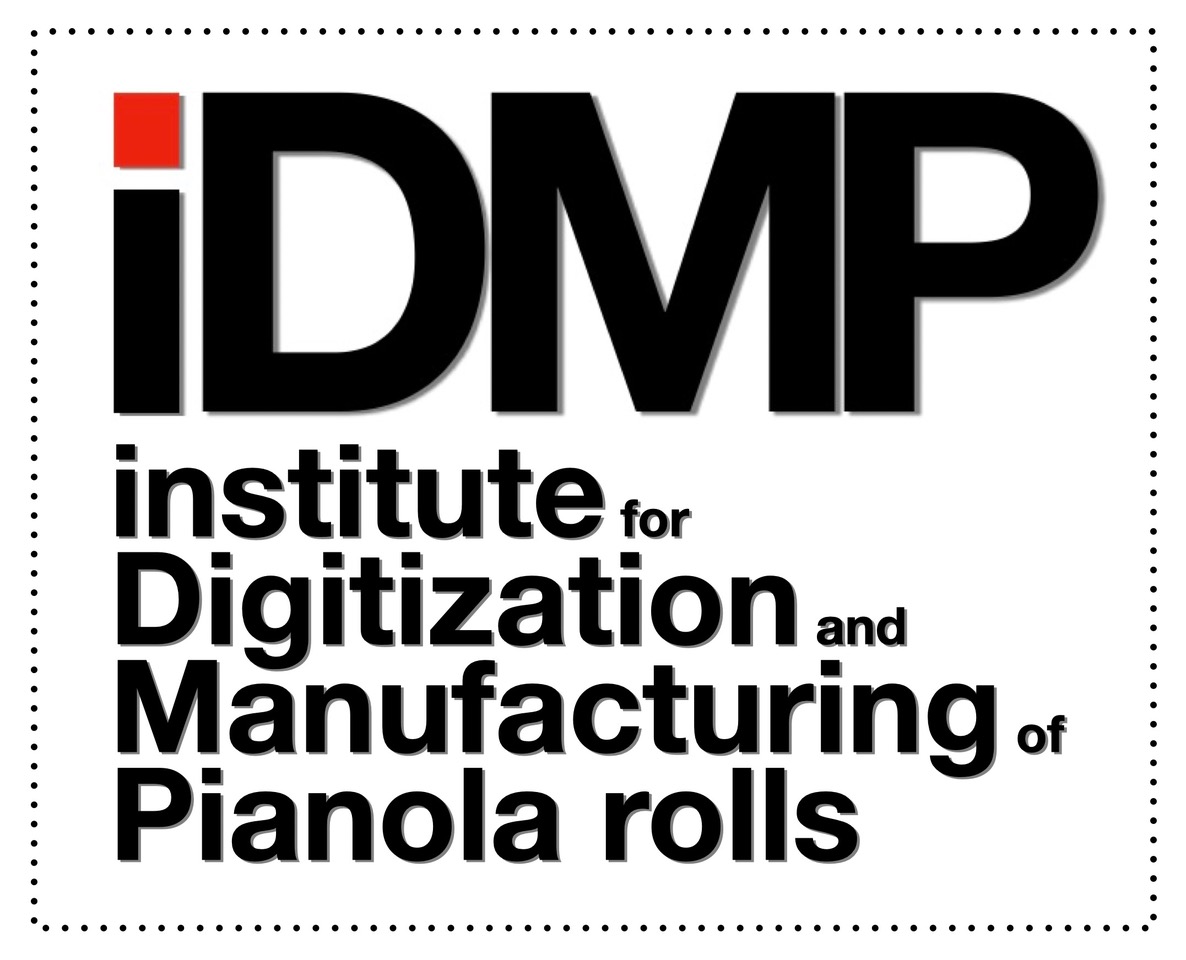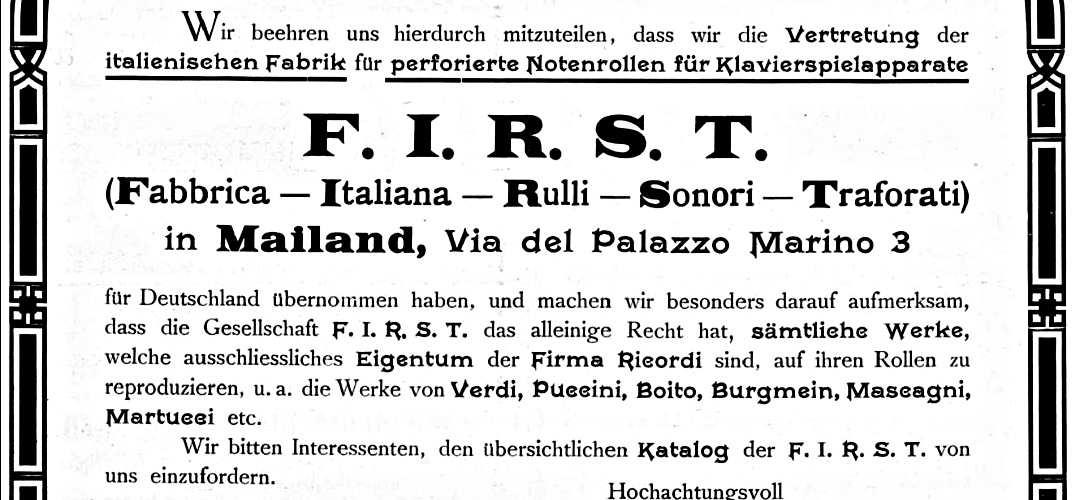The titles available on music rolls were geared towards the respective tastes of the time, which varied from region to region - i.e. differently in Germany than in the USA. At the same time, the manufacturers were also interested in being able to offer a more interesting and wider range of titles than the competition. Hupfeld claimed early on to be able to offer the most important and most complete piano literature - the "largest musical treasure trove" - while Aeolian tended to advertise with a large selection of different popular titles. In addition to the classical repertoire, the focus was increasingly on cutting-edge titles.
The political situation also had an influence on musical taste - marches (Kaiser-Friedrich marches etc.) were strongly represented in almost every repertoire - especially up to 1919. Hupfeld created a heroic tone painting "World War 1914" with accompanying texts for all phases of going to war. The music titles were usually in the areas of "classical music, opera & operetta, marches, sacred music, hits, dance and light music". The typical repertoire for a pianola comprised 30-50 rolls of music - usually composed of all musical genres.
In the book "Welte-Mignon music rolls" by G. Dangel and H.-W. Schmitz, an analysis of the most frequent titles found in the music roll repertoires of ~60 Welte-Mignon owners has been published. The top 10 are: Liszt's Liebestraum Nocturne No3, Paderewski's Minuet, Wagner's Isolden's Liebestod, Liszt's Hungarian Rhapsody No 2, Beethoven's Moonlight Sonata, Strauss' Frühlingsstimmenwalzer, Chopin's Ballade No3, Beethoven's Pathetique, Wagner's Rheingold Walhall, Chopin's Ballade No1. Even if this is certainly a Welte-Mignon-specific Top 10, it is similar to the repertoires of other German owners up to around 1930. From 1915 onwards, the German Schlager were added - in so-called potpourris or collective rolls such as Hupfeld Triphonola.
In the USA and the UK, the most popular titles by Chopin, Beethoven, Liszt and Wagner are also represented - as well as the American popular music of the 1910s-1930s such as ragtime, jazz, blues, swing, etc.. A few of these titles can also be found in the repertoires of the German pianolas of the time - but rather rarely - because this American music had not yet found its way into Germany. After 1945, this music was also occasionally brought to Germany on piano rolls. The QRS rolls continued to offer many of the modern titles for the pianola - however, the circle of owners of these pianolas had been greatly reduced in the meantime.
As the way of playing the piano was different between 1900 and 1930, the recorded music rolls in particular contain very interesting titles with sometimes very different interpretations. The pianists clearly lived out their freedom of interpretation to the point of rearranging entire passages. The discussion about so-called faithfulness to the original has survived to this day - although presumably there can never be just one opinion. Just as Beethoven allegedly refused to put his music on paper for a long time in order to avoid misinterpretation - and tried to avoid this by introducing extremely precise designations for the style of playing. Other composers listened to the interpretations of their pupils and sometimes discovered the sound they actually wanted - as once described by Vladimir Horowitz when he played a piece by S. Rachmaninoff in his presence. One title with many interpretations is Rhapsody No. 2 by F. Liszt.
Some composers around 1910 took the opportunity to record their interpretation on the music rolls, so to speak, in order to preserve the desired interpretation for posterity. There is an example of the title La Cathedrale Engloutie mentioned by A. Ord-Hume in his book "Pianola" - Claude Debussy recorded this piece at Welte (roll 2738) and it turned out that he had forgotten an important tempo indication "doppio movimento" on the published sheet music and this sounded completely different on the music roll in this passage played by the composer. From this point of view, the titles that were recorded by the composers themselves are particularly interesting. The same applies to those music rolls that were recorded by the direct pupils of the composers who died before this recording technique was available. This applies, for example, to the Sonata in B minor by Franz Liszt, recorded by the pupil Arthur Friedheim at Hupfeld (rolls 51890-51891), whose interpretation Liszt is said to have considered the best.
Although these music roll titles with recordings of the composers and pianists are rare contemporary documents, their authenticity can be judged differently. There are numerous examples here where pianists found their own recorded music rolls to be quite terrible in their reproduction. Often this will also have been due to the poor condition of the reproducing instrument - however, some music rolls have in fact simply been realised with poor quality. Not all pianists were prepared to invest time in post-production after the recording. The quote from S. Rachmaninoff about the Ampico recording mentioned on the first page was probably uttered after he had listened to the original rendition of his playing directly on the recording piano - and this certainly sounded very identical. The sometimes exuberant comments made by pianists about the various reproduction instruments should be viewed rather sceptically, as they were very often motivated by a lot of money. Eugene d'Albert is not the only pianist to subscribe to these statements about the uniqueness of several different systems. Regardless of this, the pleasure of listening to the various titles on different pianola systems and experiencing the changing tone of the same pianists over the years remains.
Many of the pianists and composers of the time recorded their titles on different systems. This was certainly due to various aspects - the technical innovation of the respective systems, the possibility of reaching many owners of these systems and, of course, the lucrative fees. When deciding in favour of one of the pianola or reproduction systems, it is interesting to check which titles are available for this system. We have compiled a list of pianists and their recordings for the various manufacturers. Approximately 700 pianists have recorded thousands of titles.


